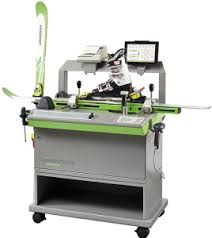🧠 What Are DIN Settings—and Why Should You Care?
If you're new to skiing, you've probably heard the word "DIN" tossed around when getting your bindings adjusted and thought, "What is it, and why does it matter?
DIN stands for Deutsches Institut für Normung, the German institute that set the industry standard for ski binding release values. Your DIN setting determines how easily your ski bindings will release your boot during a fall or sudden force. It's one of the most important safety components of your ski setup—and getting it wrong can mean the difference between skiing safely and risking injury.
🎿 What Do Ski Binding Release Values Do?
Ski bindings are designed to hold you in during normal skiing movements but release your boot during a crash to prevent twisting injuries—especially to your knees. Alpine ski bindings release laterally in the toe and vertically in the heel. Lateral heel release bindings, such as the Tyrolia Protector, are becoming more common but are not the standard in skiing.
Your DIN setting controls the amount of force it takes for your boot to release:
-
Lower DIN = easier release
-
Higher DIN = harder release
A lower DIN is typically better for beginners and lighter skiers. Higher DINs are used by more aggressive or heavier skiers who require more retention.
📊 What Affects Your DIN Setting?
Your ideal DIN is calculated based on several factors:
-
Skier Weight
-
Height
-
Age
-
Ski Boot Sole Length
-
Skiing Ability Level (Beginner, Intermediate, Advanced)
Bindings are adjusted using a DIN chart that considers all these variables. It’s not a guess—it’s a safety standard.
🔧 Why You Shouldn’t Set Bindings Yourself
Bindings must be professionally adjusted and tested. Here’s why:
-
Incorrect DIN can cause pre-release (your ski comes off when you don't want it to)
-
Or worse—no release when you fall, leading to injury
- Certified technicians test to make sure the bindings are releasing when needed by measuring the force in newton-meters and make adjustment based on the actual force needed to release
At The Pro Ski and Ride, we offer full Ski Binding Mounting and Function Testing services using calibrated equipment certified technicians to ensure your settings are correct and your bindings release exactly when they should.
Please note: Skiing is a dangerous sport and injuries may occur even when bindings are calibrated correctly.
🛠️ What’s a Function Test?
A binding function test measures the actual release force of your bindings and compares it to your calculated DIN. It’s a step beyond just setting the numbers—it confirms that the bindings perform as expected.
We use calibrated testing tools to simulate forward and twisting falls and check that the release matches your specifications. This is especially important if:
-
You’ve had your skis for multiple seasons
-
You purchased used skis
-
You’re returning from injury
-
Your bindings haven’t been tested in over a year
🧯 Safety Tip: Test Annually
We recommend all skiers get their bindings tested once per season. It’s a quick, inexpensive service that adds peace of mind every time you click in.
At The Pro Ski and Ride, all rental skis are function tested before each season for your safety.
🛍️ Buying Skis? We Mount and Test In-House
When you purchase skis and bindings together from us in person in Hunter, mounting and professional adjustment are included. We’ll calculate your DIN, mount your bindings to exact specs, and run a full release test so you can ski confidently from day one.
✅ Final Thoughts: Take Your Binding Settings Seriously
Understanding your ski binding DIN setting might not be the most exciting part of skiing—but it could be the most important. Let the experts help you get it right, so you can focus on enjoying your time on the mountain.

